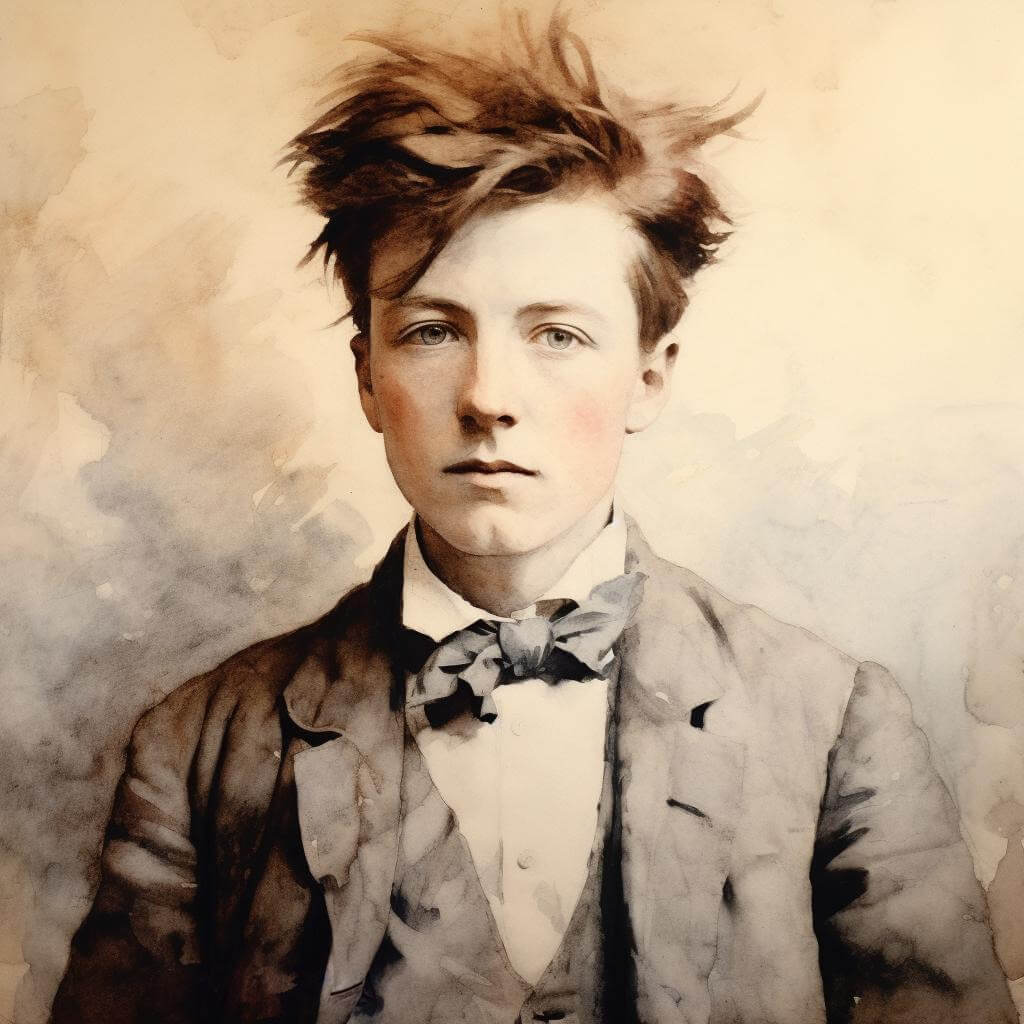Arthur Rimbaud was a rebellious French-born poet who created some iconic works during the 19th century. His life and poetry were colorful and unconventional. An example of this was his reluctance to use more orthodox techniques, and abandoning rhyme.
A prodigy from a young age, his works have become some of the most innovative and influential in the world of French literature, contributing to the Symbolist movement and leaving his mark on modern poetry. Arthur Rimbaud’s poetry was revolutionary, characterized by vivid imagery and unique use of language that broke from traditional poetic forms.
His poetic career was remarkably brief. By the age of 21, he had ceased writing poetry altogether, turning his back on the literary world to seek a different path, wandering through various parts of Europe, Asia, and Africa.
Early Life
Arthur Rimbaud was born in Charleville, France, in October 1854. He was the second son of an army captain, Frédéric Rimbaud, and his mother, Marie Catherine Vitalie Cuif. Rimbaud’s father was an infantry captain who spent the majority of his career abroad with the army. After marrying Marie, Frédéric spent very little time at home over their seven-year marriage.
Education
Rimbaud and his siblings were moved by their mother to the Cours d’Orléans in 1862. It was a neighborhood better able, as Marie assumed, to provide her children with more suitable friends and influences. Rimbaud and his brother were sent to the Pension Rossat, where they received an initial five years of education. Their mother was demanding about the time they put into their studies and often punished them with Latin verse as well as refusing them meals.
Rimbaud did not enjoy school until he arrived at the Collège de Charleville. Here, he was first exposed to fairy tales and stories of adventure. He was a very successful student and led his class in almost every subject. When Rimbaud was around fifteen years old, his skill as a poet began to show itself with his poetry. One of his first poems, ‘Ophélie,’ was written around this period. It would later be included in anthologies and considered one of his best.
By the latter part of 1870, Rimbaud had begun to rebel against a life he saw as boring actively. He ran away to Paris at one point, getting arrested and locked up in Mazas Prison. Rimbaud was also spending a great deal of time drinking and stealing. His first work ‘Les Étrennes des orphelins,’ was published in 1870. It was followed that same year by ‘Comédie en trois baisers.‘ In July of that year, the Franco-Prussian War broke out, causing his college to close down. Then, in February 1871, he joined the Paris Commune, a group of insurgents. However, this only lasted three weeks.
Paul Verlaine
Later the next year, after briefly corresponding with contemporary Paul Verlaine in Brussels, Rimbaud traveled to Paris. He stayed in the Verlaine home for a short period of time alongside Verlaine’s new wife. Rimbaud’s arrival would put extra pressure on Verlaine’s marriage. It is said that Rimbaud was responsible for ‘boorish behavior’ during his time there. The two writers carried on a short but intense love affair. There was a noted amount of alcohol and drugs involved. The two traveled to London in 1872, with Verlaine willingly leaving his wife and infant. They made a living teaching and spent their days reading. After traveling to Belgium and England, the relationship soured, and Verlaine returned to his wife.
Soon after, they attempted a reconciliation that ended with Rimbaud getting shot in the left wrist. After a short period of time passed, and Verlaine’s behavior became more erratic, he was arrested and charged with attempted murder. The charges were reduced, but Verlaine still served two years in prison.
Travels
Finally, Rimbaud returned to Charleville, where he completed his prose work ‘One Saison en Enfer‘ or ‘A Season in Hell.’ This piece is considered a prime example of Symbolist writing. In the mid-1870s, Verlaine and Rimbaud met for the last time. By this point, Rimbaud has stopped writing in favor of taking on working life. It was his goal to travel as often as possible. He moved throughout Europe mostly on foot.
In 1876, he enlisted in the Dutch Colonial Army so that he could get free passage to Java. Once there, he deserted and escaped to the jungle. He eventually returned to France undercover, knowing that if he was caught, he would face a firing squad. He later traveled to Cyprus, where he worked as a stone quarry foreman. Rimbaud contracted typhoid while there and had to return to France.
Illness and Death
By 1880, he had settled in Aden, Yemen, where he worked for the Bardey agency. As had become his custom, he soon left his job. He started his own account as a merchant in Harar, Ethiopia, where he sold coffee and firearms. After this business venture failed, and with pain in his right knee, he moved back to France. He initially thought he was suffering from arthritis and failed to get treatment. The knee became so painful he finally went to see a doctor who misdiagnosed him with tubercular synovitis and informed the writer he should have his right leg amputated. The procedure was performed in Marseille in May of 1891. After the procedure, it was discovered he was actually suffering from bone cancer.
Although his health was still tenuous, he traveled back to Africa in August. The pain only increased, and he ended up confined to his sister’s home. There, he was administered his last rites before dying in November of 1891. He was only thirty-seven. Rimbaud’s remains were sent back to France, where he was buried in Charleville-Mézières. The majority of Rimbaud’s works were published after his death. These include Les Déserts de l’amour, Proses “évangeliques,” and a great deal of his correspondence.
Famous Poems
Arthur Rimbaud was responsible for a wide array of iconic works. Here are some of his most famous poems:
- ‘Le Bateau ivre’ (The Drunken Boat)
- ‘Voyelles‘ (Vowels)
- ‘Le Dormeur du val’ (The Sleeper in the Valley)
- ‘Une Saison en enfer‘ (A Season in Hell)
- ‘Les Illuminations‘ (The Illuminations)
- ‘Ce qu’on dit au poète à propos des fleurs‘ (What the poet is told about flowers)
- ‘Soleil et chair’ (Sun and Flesh)
Influences
Arthur Rimbaud was heavily inspired by some of the great poets that came before him, alongside his peers. These included the likes of Charles Baudelaire, Paul Verlaine, Victor Hugo, Stéphane Mallarmé, Leconte de Lisle, Théophile Gautier, and Gérard de Nerval.
Many English language poets, including Samuel Beckett and John Ashbery, have translated and been influenced by Rimbaud’s works. Many other literary and artistic figures, such as Marcel Proust, André Freynaud, David Wojnarowicz, Jim Morrison, Bob Dylan, and Regina Hansen, have all attributed some credit to Rimbaud for inspiring them.
FAQs
Arthur Rimbaud was a French poet who is known for his experimental and innovative poetry, which often explored themes of rebellion, decadence, and the search for new forms of expression. He is considered one of the most important figures in the Symbolist movement, and his work has had a major influence on modern poetry.
Rimbaud’s most famous poem is ‘Le Bateau Ivre‘ (The Drunken Boat), which was published in 1871. The poem is a long, free-verse meditation on the journey of a ship that has broken free from its moorings and is sailing aimlessly on the sea. The poem is often interpreted as a metaphor for Rimbaud’s own restless and rebellious spirit.
Rimbaud stopped writing poetry at the age of 21. He had been writing poetry since he was a teenager, but he gave it up after a turbulent few years that included a passionate and destructive relationship with the poet Paul Verlaine. Rimbaud went on to travel the world and work as a merchant and explorer.
Rimbaud lived in Africa for several years, from 1880 to 1891. He worked as a trader and explorer in Ethiopia and Yemen. He also became involved in the coffee trade and is credited with helping to introduce Ethiopian coffee to the world.
Arthur Rimbaud’s poetry style was characterized by its experimentalism and innovation. He broke with traditional forms of poetry and used free verse, symbolism, and other techniques to create a new kind of poetry that was both challenging and exhilarating. His work was often influenced by his personal experiences and his search for new ways of seeing the world.


